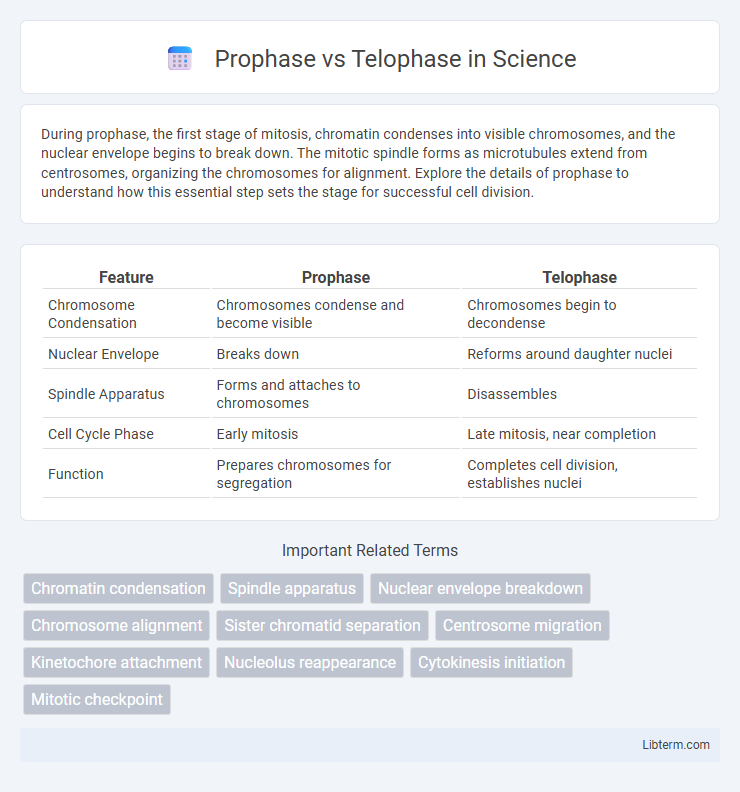During prophase, the first stage of mitosis, chromatin condenses into visible chromosomes, and the nuclear envelope begins to break down. The mitotic spindle forms as microtubules extend from centrosomes, organizing the chromosomes for alignment. Explore the details of prophase to understand how this essential step sets the stage for successful cell division.
Table of Comparison
| Feature | Prophase | Telophase |
|---|---|---|
| Chromosome Condensation | Chromosomes condense and become visible | Chromosomes begin to decondense |
| Nuclear Envelope | Breaks down | Reforms around daughter nuclei |
| Spindle Apparatus | Forms and attaches to chromosomes | Disassembles |
| Cell Cycle Phase | Early mitosis | Late mitosis, near completion |
| Function | Prepares chromosomes for segregation | Completes cell division, establishes nuclei |
Introduction to Cell Division
Prophase marks the beginning of cell division, characterized by chromatin condensation into visible chromosomes and the breakdown of the nuclear envelope. In contrast, Telophase signifies the final stage where chromosomes de-condense, nuclear membranes re-form around daughter nuclei, and the cell prepares for cytokinesis. These phases are critical in mitosis, ensuring accurate genetic material segregation for successful cell replication.
Overview of Mitosis Phases
Prophase marks the beginning of mitosis, characterized by chromatin condensation into visible chromosomes and the formation of the mitotic spindle from centrosomes. Telophase signals the end of mitosis, where chromosomes decondense back into chromatin, the nuclear envelope re-forms around each chromosome set, and the mitotic spindle disassembles. Both phases are crucial for accurate cell division, ensuring genetic material is properly organized and enclosed before cytokinesis.
What Happens During Prophase?
During prophase, chromatin condenses into distinct chromosomes, each consisting of two sister chromatids joined at the centromere. The nuclear envelope begins to break down, and the mitotic spindle starts to form from centrosomes moving toward opposite poles. Microtubules attach to kinetochores on chromosomes, preparing them for alignment during metaphase.
Key Events Characterizing Telophase
Telophase is characterized by the reformation of the nuclear envelope around the separated chromosomes, the decondensation of chromatin into less visible forms, and the beginning of cytokinesis with the cleavage furrow or cell plate formation. Unlike prophase, where chromosomes condense and the spindle apparatus forms, telophase marks the end of chromosome movement and the restoration of interphase nuclear conditions. Key events during telophase ensure the physical separation of daughter nuclei and prepare the cell for complete division.
Structural Changes: Prophase vs Telophase
During prophase, chromatin condenses into distinct chromosomes, the nuclear envelope begins to disintegrate, and spindle fibers start forming from the centrosomes. In telophase, chromosomes decondense back into chromatin, the nuclear envelope reassembles around each chromosome set, and the spindle fibers disintegrate. These structural changes mark the transition from mitotic chromosome organization to the reestablishment of the nucleus in daughter cells.
Chromosome Behavior and Condensation
During prophase, chromosomes condense into tightly coiled structures, becoming visible under a microscope as distinct entities, and the nuclear envelope begins to break down. In contrast, during telophase, chromosomes start to decondense, transitioning back into a less compact chromatin state, while new nuclear envelopes re-form around each set of chromosomes. These contrasting stages highlight the dynamic changes in chromosome condensation crucial for proper cell division.
Nuclear Envelope Dynamics
During prophase, the nuclear envelope breaks down, allowing chromosomes to condense and spindle fibers to attach. In telophase, the nuclear envelope reassembles around each set of separated chromatids, forming two distinct nuclei. This dynamic restructuring of the nuclear envelope is crucial for proper chromosome segregation and cell division completion.
Spindle Apparatus Comparison
The spindle apparatus during prophase begins to form as microtubules extend from centrosomes, organizing and attaching to chromosomes to facilitate their alignment. In telophase, the spindle apparatus disassembles after chromosomes reach opposite poles, marking the near end of mitosis. This dynamic contrast highlights the spindle's role from chromosome movement initiation to mitotic completion.
Functional Significance of Each Phase
Prophase initiates cell division by condensing chromatin into distinct chromosomes and assembling the mitotic spindle, essential for accurate chromosome alignment and segregation. Telophase completes mitosis by re-establishing the nuclear envelope around separated chromosome sets and initiating chromatin decondensation, ensuring that two daughter nuclei are fully formed and prepared for cytokinesis. Each phase is crucial for maintaining genomic integrity and enabling successful cell replication.
Summary Table: Prophase vs Telophase
Prophase initiates mitosis with chromatin condensing into visible chromosomes, the nuclear envelope breaking down, and spindle fibers forming from centrosomes. Telophase concludes mitosis by reversing these changes: chromosomes decondense into chromatin, nuclear envelopes reassemble around each set of chromosomes, and spindle fibers disintegrate. The summary table highlights key differences such as chromosome condensation in prophase versus decondensation in telophase, spindle formation versus disassembly, and nuclear envelope breakdown versus reformation.
Prophase Infographic

 libterm.com
libterm.com